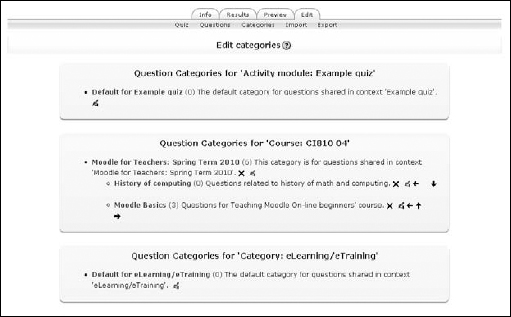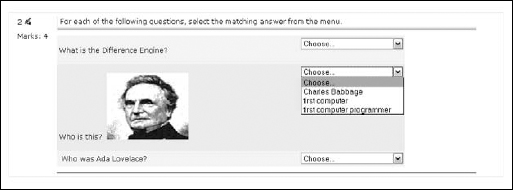Creating Quiz Questions
After you've finished setting up the quiz body, as described in the preceding section, you're ready to start adding questions to your quiz. Before you can add questions, you need to set up your question categories and then the question bank. Be sure to start by setting up categories in which to organize your questions even if you're just playing around. Over time, the categories will help you find specific questions to add to your quizzes, tests, and worksheets.
Setting up categories
Think of a question category as a folder you have set up on your computer. When creating questions, you can store them in these categories similar to the way you store files in your folders. You can set up subcategories as your question bank grows.
Setting up categories is purely for you to keep a potentially very large bank of questions organized, making it easier to search when adding the questions to your worksheets, quizzes, or tests. Each category must have a name, and you can include a short description. You can create a hierarchy and specify a parent category for each set of questions. This enables you to separate categories into categories, subcategories, sub-subcategories, and so on.
Before beginning, think of a naming convention that's intuitive to your courses and topics. You can set up categories any which way that works for you. For example, you name a Parent category Chemistry 101, and subcategories by theme: Science of Chemistry, Matter and Energy, Atomic Structure and Electron Configuration, and so on. This way, you will have a set of questions in each subcategory from which you can pull questions for quizzes, tests, reviews, mid-term, and so on. Another Parent category can be AP Chemistry, with similar subcategories. This will then enable you to choose easy and harder questions for various assignments.
To set up a category, you need to go to the editing page of your quiz.
- If this is your first time setting up a category and questions, select the quiz you just created from your course front page.
Alternatively, you can select Questions from the Administrative block on your course front page.
Moodle takes you to the Editing Quiz page shown in Figure 11-4. Note that if you click the Questions link from the Administration block, the page looks slightly different, but tabs and functionality are the same. More frequently, teachers use this process to create questions after setting up categories.
Figure 11-4: The Editing Quiz page.

- From the Edit tab, click the Categories link.
Moodle takes you to a list of default categories, as shown in Figure 11-5. You see headings for the quiz, course, category for your course, and system. Aim to store your categories either under the default course category or create your own categories.
- Scroll down until you see the Add Category section shown in Figure 11-6. From the Parent drop-down list, select the parent category that will contain your new category.
I recommend that you use your course name as the parent.
- In the Name text box, give the category name.
For example, enter Moodle for Teachers.
- In the Category Info box, describe the category.
I usually state the courses that will use questions from this category.
- Click the Add Category button to save your new category.
Notice that when Moodle saves the category and returns you to the category lists, you can edit, delete, and move the categories. Clicking the icons to the right of the name allows you to make any changes.
Figure 11-5: The Edit Categories page.

Figure 11-6: Adding question categories.

Creating a question bank
After creating categories, you're ready to start creating questions to populate the categories and then add them to your quiz. Moodle has ten types of questions you can create and add to your quizzes. You can mix and match them however you want when adding them to the quiz. There is no predetermined order, question number, and question type required by Moodle. You're in complete control of your quiz's questions and structure.
The question types in the Moodle drop-down list are as follows:
- Calculated: These types of questions are used for mathematical equations. You set up holders for specific mathematical values that are listed in the Moodle dataset. For example, you can ask students to calculate the area of a triangle by inputting 1/2 * {base} * {height}.
- Description: This is actually not a question type. It is purely a text box you embed between questions so that you can add instructions. For instance, when you come to a new set of questions that require extra information, you can add instructions for the new set, or you can add a few paragraphs and ask students to read the text and then answer a series of questions. You can also embed graphics. You will find Description useful, as most of the question types don't have input fields for instructions.
- Essay: Use essay questions for short answers; I advise no more than two paragraphs. You need to mark each essay question and assign the grades manually. If you require your learners to write a longer essay, use the Online Text Assignment module.
- Matching: This question type is represented by two columns, where text from one column must be matched with content in the other. For example, a line from a poem should be matched with the poet. I suggest that you enter the longer statement in the left column and the shorter statement in the right column, as the matches appear in a drop-down list. So in the poetry example, the line from the poem would be on the left, and authors on the right.
- Embedded Answers (Cloze): This question type allows you to embed answers such as multiple choice, short answer, and numerical answers in the text. You can embed more than one answer type and any combination. Language and math teachers like this question type.
You need to embed the syntax for the question type in the text in order for the Moodle engine to recognize it, or you need to use third-party quiz software, such as Hot Potatoes, to embed answers. Detailed explanation of the syntax is beyond the scope of this book. Check http://docs.moodle.org/en/Question_bank for a detailed explanation and examples.
- Multiple Choice: This is a familiar question type bundled with a few extras. Moodle can shuffle answers within the question. Moodle lets you select multiple answers, you can add feedback for every answer, and you can assign positive or negative grades, which discourages guessing or if you allow for your learners to take the test more than once.
- Short Answer: This question type requires learners to type in a word or phrase. Moodle allows you to choose case sensitivity, a wildcard answer (described in the upcoming “Short answer” section), and feedback. I advise you to keep answers short and add several acceptable answers. The only way Moodle can mark this is by matching text exactly. You do have an option to override the answer, though that defeats the purpose of Moodle automatic grading taking that workload off your shoulders.
 I tend to go back to short answer questions only if too many students are getting them wrong, or if a student has a borderline grade.
I tend to go back to short answer questions only if too many students are getting them wrong, or if a student has a borderline grade. - Numerical: This is just like the short answer question with extra functionality allowing you to set an accepted error range for each answer. For example, if the answer is 50, you can set up the accepted error of 3, meaning that 47, 50, and 53 would be evaluated as correct.
- Random Short-Answer Matching: For learners, this question looks just like matching; however, you provide several answers for each subquestion. So instead of two long lists as in the matching question, each subquestion has two to three possible choices. See Figure 11-7 for an example of how this question looks when presented to learners. Notice that the question has three subquestions and a drop-down list for each.
- True/False: Learners are given two choices for each question, true or false. The format for setting this question type is similar to multiple choice, though simpler.
Figure 11-7: A short-answer matching question.

When creating your questions, you're following a similar format to setting up some of the other activities. Moodle provides you with a form with various options for each question type. The form is consistent in layout, and you need to input each question, the answers, and the feedback. It does take some time to create a complete bank of questions. But remember, you have to do this only once. Start small; for example, add one quiz or worksheet. Moodle marks and pushes the grades to the grade book. Don't get discouraged. It may be a slow process until you get the hang of it. Remind yourself that you can reuse the questions over and over.
